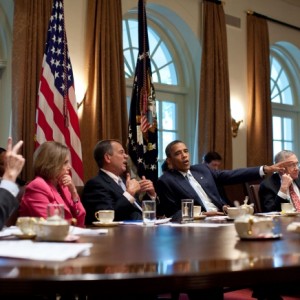All across America, Wall Street is grabbing money meant for public workers

Illustration by Victor Juhasz
By Matt Taibbi
Detroit's Debt Crisis: Everything Must Go
Called the Rhode Island Retirement Security Act of 2011, her plan would later be hailed as the most comprehensive pension reform ever implemented. The rap was so convincing at first that the overwhelmed local burghers of her little petri-dish state didn't even know how to react. "She's Yale, Harvard, Oxford – she worked on Wall Street," says Paul Doughty, the current president of the Providence firefighters union. "Nobody wanted to be the first to raise his hand and admit he didn't know what the fuck she was talking about."
Soon she was being talked about as a probable candidate for Rhode Island's 2014 gubernatorial race. By 2013, Raimondo had raised more than $2 million, a staggering sum for a still-undeclared candidate in a thimble-size state. Donors from Wall Street firms like Goldman Sachs, Bain Capital and JPMorgan Chase showered her with money, with more than $247,000 coming from New York contributors alone. A shadowy organization called EngageRI, a public-advocacy group of the 501(c)4 type whose donors were shielded from public scrutiny by the infamous Citizens United decision, spent $740,000 promoting Raimondo's ideas. Within Rhode Island, there began to be whispers that Raimondo had her sights on the presidency. Even former Obama right hand and Chicago mayor Rahm Emanuel pointed to Rhode Island as an example to be followed in curing pension woes.
What few people knew at the time was that Raimondo's "tool kit" wasn't just meant for local consumption. The dynamic young Rhodes scholar was allowing her state to be used as a test case for the rest of the country, at the behest of powerful out-of-state financiers with dreams of pushing pension reform down the throats of taxpayers and public workers from coast to coast. One of her key supporters was billionaire former Enron executive John Arnold – a dickishly ubiquitous young right-wing kingmaker with clear designs on becoming the next generation's Koch brothers, and who for years had been funding a nationwide campaign to slash benefits for public workers.
Nor did anyone know that part of Raimondo's strategy for saving money involved handing more than $1 billion – 14 percent of the state fund – to hedge funds, including a trio of well-known New York-based funds: Dan Loeb's Third Point Capital was given $66 million, Ken Garschina's Mason Capital got $64 million and $70 million went to Paul Singer's Elliott Management. The funds now stood collectively to be paid tens of millions in fees every single year by the already overburdened taxpayers of her ostensibly flat-broke state. Felicitously, Loeb, Garschina and Singer serve on the board of the Manhattan Institute, a prominent conservative think tank with a history of supporting benefit-slashing reforms. The institute named Raimondo its 2011 "Urban Innovator" of the year.
The state's workers, in other words, were being forced to subsidize their own political disenfranchisement, coughing up at least $200 million to members of a group that had supported anti-labor laws. Later, when Edward Siedle, a former SEC lawyer, asked Raimondo in a column for Forbes.com how much the state was paying in fees to these hedge funds, she first claimed she didn't know. Raimondo later told the Providence Journal she was contractually obliged to defer to hedge funds on the release of "proprietary" information, which immediately prompted a letter in protest from a series of freaked-out interest groups. Under pressure, the state later released some fee information, but the information was originally kept hidden, even from the workers themselves. "When I asked, I was basically hammered," says Marcia Reback, a former sixth-grade schoolteacher and retired Providence Teachers Union president who serves as the lone union rep on Rhode Island's nine-member State Investment Commission. "I couldn't get any information about the actual costs."
This is the third act in an improbable triple-fucking of ordinary people that Wall Street is seeking to pull off as a shocker epilogue to the crisis era. Five years ago this fall, an epidemic of fraud and thievery in the financial-services industry triggered the collapse of our economy. The resultant loss of tax revenue plunged states everywhere into spiraling fiscal crises, and local governments suffered huge losses in their retirement portfolios – remember, these public pension funds were some of the most frequently targeted suckers upon whom Wall Street dumped its fraud-riddled mortgage-backed securities in the pre-crash years.
Today, the same Wall Street crowd that caused the crash is not merely rolling in money again but aggressively counterattacking on the public-relations front. The battle increasingly centers around public funds like state and municipal pensions. This war isn't just about money. Crucially, in ways invisible to most Americans, it's also about blame. In state after state, politicians are following the Rhode Island playbook, using scare tactics and lavishly funded PR campaigns to cast teachers, firefighters and cops – not bankers – as the budget-devouring boogeymen responsible for the mounting fiscal problems of America's states and cities.
Secrets and Lies of the Bailout
Not only did these middle-class workers already lose huge chunks of retirement money to huckster financiers in the crash, and not only are they now being asked to take the long-term hit for those years of greed and speculative excess, but in many cases they're also being forced to sit by and watch helplessly as Gordon Gekko wanna-be's like Loeb or scorched-earth takeover artists like Bain Capital are put in charge of their retirement savings.









